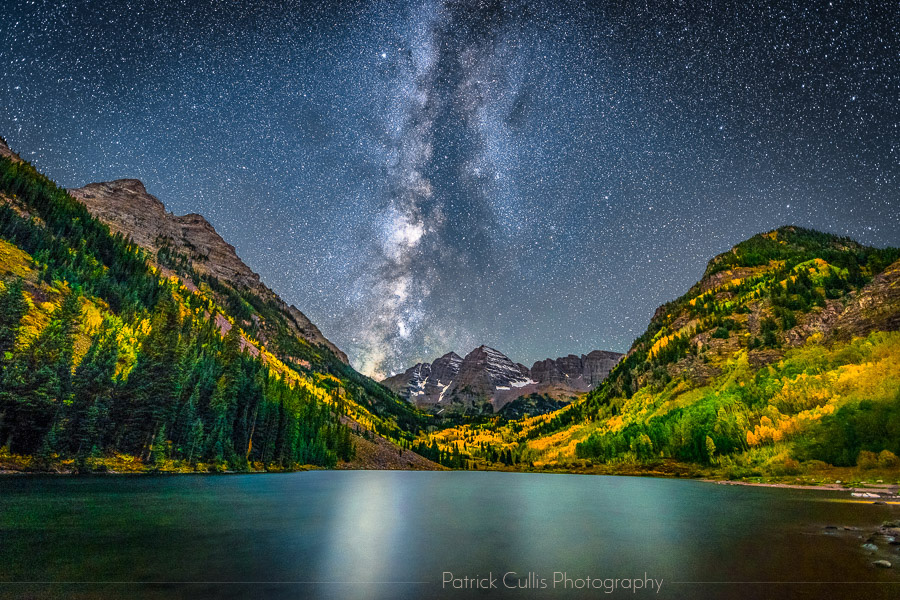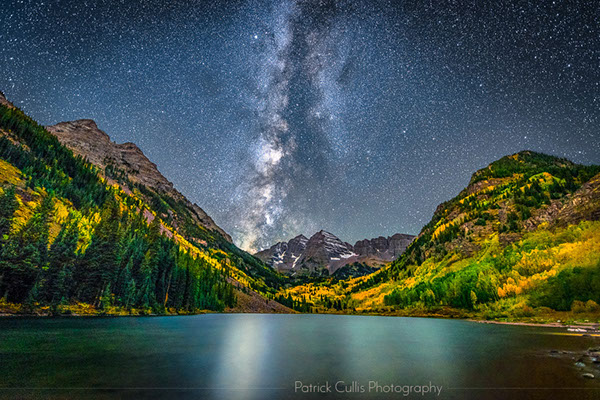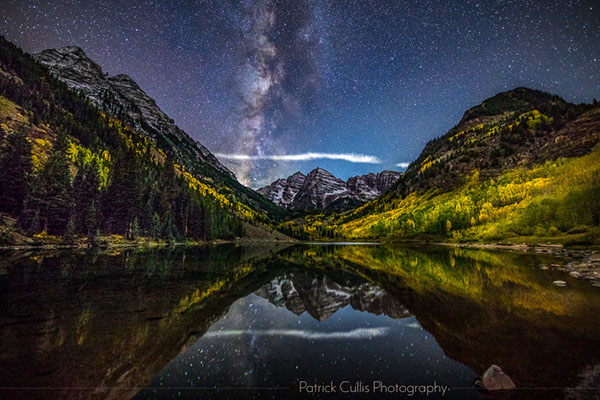The Maroon Bells












<
>
The Milky Way over the Maroon Bells in fall
Nocturnal reflection at the Maroon Bells
A cloudy, moonlit night at the Maroon Bells
A zoomed view of the Milky Way setting behind the Maroon Bells
Moonrise on the Maroon Bells with the Milky Way
Sirius, Orion, Taurus, and the Pleiades above the Maroon Bells in November
Moonlit long exposure of the Maroon Bells
Fall under moonlight at the Maroon Bells
The moon passing behind the Maroon Bells at night
The moon and the Maroon Bells
The moon and Maroon Bells in fall
Snow covered Maroon Bells in November












One crystal clear summer night in 2016 I was in Aspen, Colorado. A spur of the moment midnight drive up to the Maroon Bells began my obsession with the iconic peaks. I stood in wonder beneath the Milky Way and took the first of many exposures, wondering if I could actually capture the most photographed mountains in the United States in a way people haven’t already seen a thousand times.
Later that year I made two additional trips to the Maroon Bells after that first chance occurrence. The second time I went with a better idea of when the Milky Way would pass behind the mountains, but there were forest fires in the west and smoke clouded the air. The third trip was in fall to capture the yellow aspen leaves, but a full moon faded the stars and an approaching storm built clouds. The next day a wet snow ended the show.



During that first year, I was mostly restricted to long exposures with star streaks. I did not fully realize just how dark it was out there and how little information I would be able to pull from the landscape when properly exposing for the Milky Way. Landscape photography is a balancing act between the brightness of the land and brightness of the sky, and the Milky Way completely overpowers a moonless landscape. During the final trip I had the opposite problem when I had to contend with a full moon. A full moon casts extremely harsh shadows and photographs tend to look like they were taken at high noon. Only the faint stars in a deep blue sky hint at their nocturnal nature. I have since discovered that in truly dark skies, between 20% and 35% is an ideal moon to illuminate the landscape without washing out the stars in the sky.

Throughout winter I thought about those pictures and what I would have done differently. I thought about gear and exposures. I plotted the scene on graph paper so I could easily see where celestial objects would be and how different lenses would frame the scene. I added references for the Milky Way, and the constellation trifecta of Orion, Taurus, and the Pleiades. I put phases of the moon and rise/set times on my calendar. I would be ready next year.
The summer of 2017 was when the entire state of Oregon seemed to catch fire. The skies of Colorado were smoky and orange from their blazes throughout summer. Finally, in September, the sky cleared right in time for the aspen trees to make their annual show. Over the span of 9 days I made three trips from Boulder to the Bells.

With my experience in astrophotography I started thinking about how I could use some of that gear and methodology to improve the quality of the sky in my landscape photographs. The viewpoint of the Maroon Bells is accessed by a short, flat dirt path from the parking lot. Ideal for a lot of photography gear...
When photographing at night, there is a time limit for each lens when the stars go from pleasing points of light to stubby little streaks. Even with my 14mm super-wide-angle lens, that maxes out at around 17 seconds. Even with fast, expensive lenses, that means you will be pushing the ISO high in order to expose the landscape. Setting up my tracking mount beside the water, I was now free of that time limit and able to track the stars through the sky for extended periods of time. This also means that I am able to use much tighter zoom while keeping the sky and land crisp and sharp. The problem is that tracking the stars just transfers the problem from the sky to the land. There are two primary options. You can track at half speed, spreading out the blur evenly between the land and sky. Or, I need to take a second, identical exposure, but with the tracking turned off. I always try to change up my habits, but with vistas facing east or west, I typically choose two separate exposures due to their simplicity in merging frames. Looking North or south I will track at half speed. Since I take the exposures so close together, and with the same camera settings, the transition point between the land and sky is exposed exactly the same in both photographs. This makes combination of the frames a trivial operation.

Using this method, I was able to step down the aperture to a point where the stars are much more pleasing. It also makes the landscape sharper to use additional exposure length instead of boosting ISO. All I have to get over is my self guilt that I'm somehow "cheating" to get these shots. At shows, people will even go out of their way to tell me to my face that these aren't "real" photographs. For a period of time this really bothered me. I would get defensive and doubt myself and the art I was spending so much time and effort to create. What even is a "real" photograph? This method is no different than all the panoramas people accept as "real". I think what it really comes down to is intent. I'm not trying to "trick" people with my photographs. My intent is to show a tiny sliver of the real world in a way people haven't been able to see it before. A zoomed in view of the Milky Way really is that glorious and it can be jarring to finally see it referenced with earthly landmarks instead of an abstract deep-sky image.
Photography has always been a two part experience. First there is the exposure followed by long hours in the darkroom. Even Ansel Adams spent enormous amounts of time editing his photographs in to the masterpieces we know today. Eventually, I got to the point where I was able to be confident in what I'm doing and to stop worrying about what other people think. Art has always been a terrifying space when you have self doubt. I just need to follow my own code, be truthful and open about what I'm doing, and pursue what I love 100%


There are moments when split tracking a scene causes problems of its own. Like what to do with the reflection in water. When the water ripples, a long exposure fades it out, so you can use the landscape portion just fine. When the water is still, the reflection causes a third angular motion that I can't track. That is when you need to go back to a short exposure and instead get creative with your lighting.
As the week progressed, the waxing crescent moon was growing larger and the next night it would move in front of the Milky Way. I wanted to make one last trip and thankfully the last night to photograph our home galaxy stretched out above the Maroon Bells lined up with a forecast of crystal clear skies. When the moon passed below the peaks, but before it had actually set, a thin band of clouds appeared at the same time the water turned to glass. I was ecstatic about the breeze dying down, but the cloud was not what I wanted. I had the tracking mount but the still water meant I needed to stay with single, short exposures. For five minutes the conditions were perfect as I cycled through my go-to settings. I was initially confused by how much detail I was getting in the trees until I realized it was the cloud acting like a reflector held up in the sky. I forgave the cloud...

Fall at the Maroon Bells is the time of year when it's shoulder-to-shoulder for sunrise and between a couple and a couple dozen people photographing in the middle of the night. November is a different story.
I always wanted to photograph Orion above the Maroon Bells but Orion is a winter constellation and the road closes from November through Memorial Day. Unless I wanted to ski the 7 miles, each way, in the middle of the night, I would have to work with the conditions on either end of the closure. As we move in to November, Orion and its companion constellations finally reach the western sky just before morning twilight. That also lines up with the possibility of using a small crescent moon rising in the east to illuminate the scene. On the morning of November 12, only a couple days before the road closed for the year, the conditions came together and I made a final trip up to the Bells.

The Maroon Bells are a special place to me and I expect to be back many times in the future. I know there will be crowds and that's okay. It is what it is, but I will cherish the times I found myself out there all alone under the stars capturing a small sliver of their majestic beauty.














